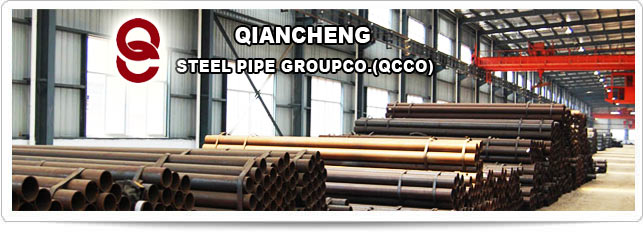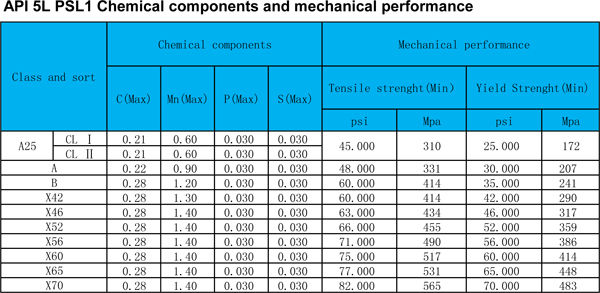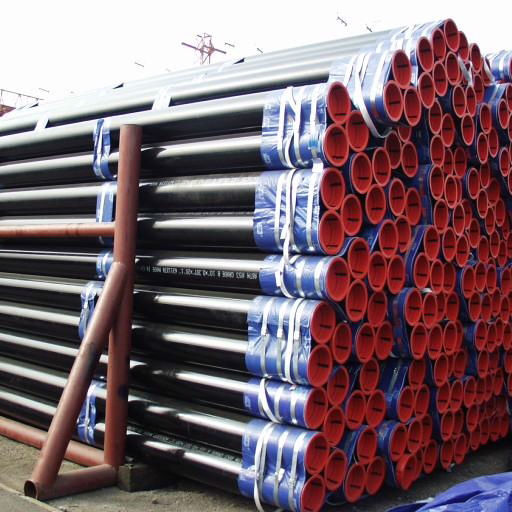natural gas pipeline,pipe wall thickness calculation
Home >
-
API steel pipe
- API steel pipe
- API steel casing pipe
- Casing and Tubing
- API drill pipe
- API5L steel pipe
- Oil pipeline

-
Carbon steel pipe
- Carbon steel pipe
- Welded steel Pipe
- seamless carbon steel pipe
- Petroleum Casing Pipe

-
Alloy steel pipe
- astm a 335 gr p22
- alloy steel pipe l555
- 25crmo4 alloy steel pipe
- alloy pipe a335 p11









One of the Top 500 enterprises in China foreign trade
QCCO was approved as a member of “China Association for Contracting Projects Abroad “and granted a membership certificate on Sep 28,2005; “Credibility Rating AAA certificate in Foreign Trade” was granted to QCCO by China Shippers’ Association

1. Standard : API 5L
2. Materiall : Gr.B
3. Size : 1/2"~24"
4. Wall Thickness : SCH10~XS

5. Pipe End : Plain end below 2" ,Bevelled end above 2"
6. Surface : Oil-Coating, Varnish, or End-Protection by Plastic Caps to Be Confirmed
7. Application: Oil & Gas Industrial ,Vessel Construction,Water Transportation
Quality Control :
Our quality control department consists of experienced technicians. These personnel strictly control the whole production procedure, from introduction of raw materials to finish products. They ensure high quality products for our customers.

High pressure pipeline,pipe wall thickness calculation
-
2 straight pipe wall thickness calculationEither cold-formed bends or hot bending bends using made straight pipe bending, therefore, to calculate the wall thickness of the bend should first determine the straight pipe wall thickness. GB 50251-2003 "gas pipeline project design specifications and GB 50028-2006 Town Gas Design Code" straight pipe wall thickness formula is the same, are the elastic failure criteria, the maximum shear stress theory to derive and obtained. Straight pipe wall thickness following formula shall be calculated:
 Where delta - Steel Pipe calculated wall thickness, mmp - design pressure, MPaD - pipe diameter, mmsigma s - minimum yield strength of the steel pipe, MPaPhi - weld factor required to select 1.0F - strength design factor3 straight pipe yield strength of elbow wall thicknessSigma s is a very important parameter when performing straight pipe wall thickness is calculated, the yield strength . Pipes of different materials, the yield strength. Pipeline delivery of the type by the heat treatment condition, the yield strength is also different. Of particular note is the heat treatment of the delivery pipeline.GB 50028-2006 "the provisions of Article 6.4.7: For the use of the cold and then heat-treated steel pipe used when the heating temperature is higher than 320 ° C (welding) or cold working or heat treatment of steel simmer bent elbow, in the calculation of the steel pipe or elbow wall thickness, the yield strength shall be taken as the minimum yield strength of the pipe (sigma s ) 75%.GB 50251-2003 gas pipeline project design specifications 5.1.5 is consistent with GB 50028-2006 "Town Gas Design Code" the provisions of Article 6.4.7. The provision states: the cold working of the steel pipe (controlled rolling, cold expansion, etc.), increased by 20% to 30% due to the strain hardening phenomenon and steel thermomechanical treatment, the yield strength of the pipe. However, due to the deformation to improve the yield strength as the tempering temperature increased gradually disappear. Usually, a large phase organizational changes at 300 ~ 320 ° C at 480 ~ 485 ° C to enhance the effect disappeared. Therefore, when the the pipe specification stressed cold working and heat treatment is carried out, the yield strength should be taken for cold pipe 75% of the yield strength.Typically, the high pressure natural gas pipeline in accordance with GB / T 9711.2-1999 "Petroleum and natural gas industries - Steel pipe for pipelines - Technical delivery conditions - Part 2: B-grade steel quality standard steel pipe. L360 steel, for example, the standard L360 supplier, for the L360NB (normalized or deformation normalizing) L360QB (quenching and tempering), and L360MB (thermomechanical treatment). The standard 7.3 Note 8, there will be adverse changes in the mechanical properties of thermo-forming and (or) followed by on-site heat treatment in the state of the quenched and tempered or thermomechanical treatment delivery pipe. 3.3.2 of the standard thermomechanical treatment is a deformation process. In this process, the final deformation completed within a certain temperature range, so that the material having a heat treatment alone can not achieve or repeated some performance. Then heated to 580 ° C or above will reduce the intensity values.For cold-formed elbows, the production process does not use a secondary heat treatment. Therefore, the yield strength changes caused by the pipeline Delivery Status calculation of its wall thickness.The hot bending bends, the pipe the simmer bend the heating temperature is generally from 800 to 1000 ° C, steel pipe, bending state for thermomechanical treatment process is bound to its strength reduced to varying degrees. Therefore, as thermomechanical treatment steel the mother tube heat bending bends, wall thickness calculation should pay attention to the base material supply heat-treated condition. After cold working steel mechanical properties that is not as finished hot bending bends sigma s sigma s indicators should be based on the mechanical properties after cold working steel pipe sigma s 75% of as thermal bending bends the sigma s indicators.4 increased wall thickness coefficient elbow wall thicknessAccording to GB 50251-2003 "gas pipeline project design specifications," the provisions of Article 5.3.3, the elbow wall thickness should be calculated as follows:
Where delta - Steel Pipe calculated wall thickness, mmp - design pressure, MPaD - pipe diameter, mmsigma s - minimum yield strength of the steel pipe, MPaPhi - weld factor required to select 1.0F - strength design factor3 straight pipe yield strength of elbow wall thicknessSigma s is a very important parameter when performing straight pipe wall thickness is calculated, the yield strength . Pipes of different materials, the yield strength. Pipeline delivery of the type by the heat treatment condition, the yield strength is also different. Of particular note is the heat treatment of the delivery pipeline.GB 50028-2006 "the provisions of Article 6.4.7: For the use of the cold and then heat-treated steel pipe used when the heating temperature is higher than 320 ° C (welding) or cold working or heat treatment of steel simmer bent elbow, in the calculation of the steel pipe or elbow wall thickness, the yield strength shall be taken as the minimum yield strength of the pipe (sigma s ) 75%.GB 50251-2003 gas pipeline project design specifications 5.1.5 is consistent with GB 50028-2006 "Town Gas Design Code" the provisions of Article 6.4.7. The provision states: the cold working of the steel pipe (controlled rolling, cold expansion, etc.), increased by 20% to 30% due to the strain hardening phenomenon and steel thermomechanical treatment, the yield strength of the pipe. However, due to the deformation to improve the yield strength as the tempering temperature increased gradually disappear. Usually, a large phase organizational changes at 300 ~ 320 ° C at 480 ~ 485 ° C to enhance the effect disappeared. Therefore, when the the pipe specification stressed cold working and heat treatment is carried out, the yield strength should be taken for cold pipe 75% of the yield strength.Typically, the high pressure natural gas pipeline in accordance with GB / T 9711.2-1999 "Petroleum and natural gas industries - Steel pipe for pipelines - Technical delivery conditions - Part 2: B-grade steel quality standard steel pipe. L360 steel, for example, the standard L360 supplier, for the L360NB (normalized or deformation normalizing) L360QB (quenching and tempering), and L360MB (thermomechanical treatment). The standard 7.3 Note 8, there will be adverse changes in the mechanical properties of thermo-forming and (or) followed by on-site heat treatment in the state of the quenched and tempered or thermomechanical treatment delivery pipe. 3.3.2 of the standard thermomechanical treatment is a deformation process. In this process, the final deformation completed within a certain temperature range, so that the material having a heat treatment alone can not achieve or repeated some performance. Then heated to 580 ° C or above will reduce the intensity values.For cold-formed elbows, the production process does not use a secondary heat treatment. Therefore, the yield strength changes caused by the pipeline Delivery Status calculation of its wall thickness.The hot bending bends, the pipe the simmer bend the heating temperature is generally from 800 to 1000 ° C, steel pipe, bending state for thermomechanical treatment process is bound to its strength reduced to varying degrees. Therefore, as thermomechanical treatment steel the mother tube heat bending bends, wall thickness calculation should pay attention to the base material supply heat-treated condition. After cold working steel mechanical properties that is not as finished hot bending bends sigma s sigma s indicators should be based on the mechanical properties after cold working steel pipe sigma s 75% of as thermal bending bends the sigma s indicators.4 increased wall thickness coefficient elbow wall thicknessAccording to GB 50251-2003 "gas pipeline project design specifications," the provisions of Article 5.3.3, the elbow wall thickness should be calculated as follows: Where delta b - elbow or knee wall thickness, mmdelta - elbows or bends connected by straight pipe wall thickness, mmm - elbow or knee wall thickness increasing coefficientR - radius of curvature of the elbow or knee, mm- elbows or bends the outer diameter, mmThis formula is mainly consider bending in under the action of fluid pressure, the resulting hoop stress along the bending cross-sectional distribution is very uneven. Maximum hoop stress in the bend of the concave point, the point stress than straight pipe hoop stress, increasing multiples referred to as stress increases elbow under internal pressure coefficient. Therefore, in the calculation of the bending wall thickness, in the straight tube wall thickness based on considering a wall thickness increasing coefficient m. The coefficient m is a function of the elbow and the outer diameter D of the radius of curvature R. The greater the radius of curvature R, the wall thickness of the elbow increases the smaller the coefficient m, and the need to increase the thickness of the elbow, a large number of smaller, the greater the contrary.According to GB 50251-2003 "gas pipeline project design specifications" 4.3.13, the minimum radius of curvature of the cold-formed bends in Table 1.Cold-formed bend in Table 1 Minimum radius of curvatureNominal diameter / mmSmallest radius of curvature≤ 30018D35021D40024D45027D≥ 50030DIn accordance with the provisions of Article 4.3.13 of the GB 50251-2003 "gas pipeline project design specifications", the radius of curvature of the elbow should be greater than or equal to 4 times the outer diameter, and should meet the pig or testing instruments able to pass the requirements. According to SY / T 5257-2004 "oil and gas transmission steel pipe" the provisions of Article 3.1 of the radius of curvature of the bend is not less than five times the outer diameter. Meanwhile, according to GB 50470-2008 "oil and gas transmission pipeline engineering section 7.1.4 of the Code for Seismic Design of buried pipelines need to earthquake-proof, when set hot simmer elbow, the radius of curvature shall not be less than 6D; when set cold bend radius of curvature shall not be less than the 30D.Therefore, high pressure natural gas pipeline cold-formed bend radius of curvature is usually taken to 30D, the the heat simmer bend radius of curvature is usually taken as the 6D. Wall thickness calculated according to formula (3) the increasing coefficient results are shown in Table 2.Table 2 increased wall thickness calculated resultsBend nameThe elbow curvature radius RIncreased wall thickness coefficient mCold-formed elbows30D1.01Hot simmer elbow6D1.O55 wall thinning rate of elbow wall thicknessWall thinning rate refers to the ratio of the difference between the actual wall thickness of the main pipe and elbows arc side wall thickness with the parent pipe wall thickness. High pressure natural gas pipeline bending the pipe section will be affected by the deformation. The inside of the pipe wall (i.e. the inner arc of the elbow side) by the pressure wall by a straight shape becomes circular arc-shaped wall thickening due to compression shorter; the outer wall of the pipe (i.e., elbow outer arc side) by the tension, the same wall straight into the arc-shaped wall thinning due to pull longer [1] . Wall thinning will reduce the strength of the pipe. Order to ensure the strength to meet the requirements of the elbow, the elbow should have a certain thickness. Thinning rate data, on the one hand, is determined according to the requirements of the relevant specification, on the other hand through a theoretical analysis of the derivation of the formula to calculate.5.1 Compliant empirical dataGB 50028-2006 Town Gas Design Code "bent pipe wall thickness calculation performed according to GB 50251-2003" gas pipeline project design specifications ". GB 50251-2003 gas pipeline project design specifications "does not require wall thinning rate of the elbow, only require elbow thinnest thickness not less than the thickness of the straight pipe, pipe strength not less than the minimum yield strength can be. At present, SY / T 5257-2004 "oil and gas transmission steel elbow requirements elbow wall thinning rate shall not be greater than 9%.5.2 Theoretical calculation of the formula dataThe theory of wall thinning rate formula is based on the principle of conservation of mass, equal to the amount of thickening of the inner wall of outer wall thinning based derive out. [1] given the elbow wall thinning rate is calculated as follows:
Where delta b - elbow or knee wall thickness, mmdelta - elbows or bends connected by straight pipe wall thickness, mmm - elbow or knee wall thickness increasing coefficientR - radius of curvature of the elbow or knee, mm- elbows or bends the outer diameter, mmThis formula is mainly consider bending in under the action of fluid pressure, the resulting hoop stress along the bending cross-sectional distribution is very uneven. Maximum hoop stress in the bend of the concave point, the point stress than straight pipe hoop stress, increasing multiples referred to as stress increases elbow under internal pressure coefficient. Therefore, in the calculation of the bending wall thickness, in the straight tube wall thickness based on considering a wall thickness increasing coefficient m. The coefficient m is a function of the elbow and the outer diameter D of the radius of curvature R. The greater the radius of curvature R, the wall thickness of the elbow increases the smaller the coefficient m, and the need to increase the thickness of the elbow, a large number of smaller, the greater the contrary.According to GB 50251-2003 "gas pipeline project design specifications" 4.3.13, the minimum radius of curvature of the cold-formed bends in Table 1.Cold-formed bend in Table 1 Minimum radius of curvatureNominal diameter / mmSmallest radius of curvature≤ 30018D35021D40024D45027D≥ 50030DIn accordance with the provisions of Article 4.3.13 of the GB 50251-2003 "gas pipeline project design specifications", the radius of curvature of the elbow should be greater than or equal to 4 times the outer diameter, and should meet the pig or testing instruments able to pass the requirements. According to SY / T 5257-2004 "oil and gas transmission steel pipe" the provisions of Article 3.1 of the radius of curvature of the bend is not less than five times the outer diameter. Meanwhile, according to GB 50470-2008 "oil and gas transmission pipeline engineering section 7.1.4 of the Code for Seismic Design of buried pipelines need to earthquake-proof, when set hot simmer elbow, the radius of curvature shall not be less than 6D; when set cold bend radius of curvature shall not be less than the 30D.Therefore, high pressure natural gas pipeline cold-formed bend radius of curvature is usually taken to 30D, the the heat simmer bend radius of curvature is usually taken as the 6D. Wall thickness calculated according to formula (3) the increasing coefficient results are shown in Table 2.Table 2 increased wall thickness calculated resultsBend nameThe elbow curvature radius RIncreased wall thickness coefficient mCold-formed elbows30D1.01Hot simmer elbow6D1.O55 wall thinning rate of elbow wall thicknessWall thinning rate refers to the ratio of the difference between the actual wall thickness of the main pipe and elbows arc side wall thickness with the parent pipe wall thickness. High pressure natural gas pipeline bending the pipe section will be affected by the deformation. The inside of the pipe wall (i.e. the inner arc of the elbow side) by the pressure wall by a straight shape becomes circular arc-shaped wall thickening due to compression shorter; the outer wall of the pipe (i.e., elbow outer arc side) by the tension, the same wall straight into the arc-shaped wall thinning due to pull longer [1] . Wall thinning will reduce the strength of the pipe. Order to ensure the strength to meet the requirements of the elbow, the elbow should have a certain thickness. Thinning rate data, on the one hand, is determined according to the requirements of the relevant specification, on the other hand through a theoretical analysis of the derivation of the formula to calculate.5.1 Compliant empirical dataGB 50028-2006 Town Gas Design Code "bent pipe wall thickness calculation performed according to GB 50251-2003" gas pipeline project design specifications ". GB 50251-2003 gas pipeline project design specifications "does not require wall thinning rate of the elbow, only require elbow thinnest thickness not less than the thickness of the straight pipe, pipe strength not less than the minimum yield strength can be. At present, SY / T 5257-2004 "oil and gas transmission steel elbow requirements elbow wall thinning rate shall not be greater than 9%.5.2 Theoretical calculation of the formula dataThe theory of wall thinning rate formula is based on the principle of conservation of mass, equal to the amount of thickening of the inner wall of outer wall thinning based derive out. [1] given the elbow wall thinning rate is calculated as follows: Where C - pipe wall thinning rateThis formula can be seen, the elbow wall thinning rate mainly depends on the radius of curvature of the bend. The larger the radius of curvature of feet, wall thinning rate C is smaller, the greater the contrary. According to formula (4) the thinning rate calculated results are shown in Table 3.Table 3 wall thinning rate resultsBend nameThe elbow curvature radius RWall thinning rate /%Cold-formed elbows30D1.64Hot simmer elbow6D7.69Consider elbow wall thickness of the wall thinning rate is calculated as follows:
Where C - pipe wall thinning rateThis formula can be seen, the elbow wall thinning rate mainly depends on the radius of curvature of the bend. The larger the radius of curvature of feet, wall thinning rate C is smaller, the greater the contrary. According to formula (4) the thinning rate calculated results are shown in Table 3.Table 3 wall thinning rate resultsBend nameThe elbow curvature radius RWall thinning rate /%Cold-formed elbows30D1.64Hot simmer elbow6D7.69Consider elbow wall thickness of the wall thinning rate is calculated as follows: 6 pipe wall thickness calculationTo be laid in the three areas (strength design factor F 0.4), the design pressure of 4.0MPa, the pipe diameter of 406.4mm, made of L360MB urban high-pressure natural gas pipeline, for example cold-formed elbows, heat bending bends wall thickness.For cold-formed elbow L360MB yield strength of 360MPa, and the straight pipe wall thickness is calculated according to formula (1) obtained 5.644mm; according to formula (2) and the results of Table 2 the calculated thickness of the cold-formed bend. 5.700mm; taking into account the thinning rate in the production, processing, calculated according to formula (5) and the results of Table 3 Roll elbow wall thickness of 5.795mm.For the heat simmer elbow L360MB yield strength should be 75% of 360MPa 270MPa consider, according to formula (1) calculated by the straight tube wall thickness is 7.525mm; calculated according to formula (2) and the results of Table 2 Thermal simmer bend the wall thickness is 7.901mm; the thinning rate when taking into account the production and processing, the to calculate the heat simmer bend obtained according to the formula (5) and the results in Table 3 the wall thickness is 8.559mm.Elbow wall thickness should be calculated in accordance with the requirements of the relevant norms rounded, at the same time should match the wall thickness of the line straight pipe section.References:[ Liu Zhiren, Tao Chunhui, high pressure natural gas pipeline elbow wall thinning rate [J]. gas heat, 2011,31 (4): B04-B05.(The author: Zhou Rong Jian Wang Yiwen 1 1 2 . Machinery International Engineering Design and Research Institute Co., Ltd. Nanjing, Jiangsu 210042; 2. Architectural Design and Research Institute of Southeast University, Jiangsu Nanjing 210096)
6 pipe wall thickness calculationTo be laid in the three areas (strength design factor F 0.4), the design pressure of 4.0MPa, the pipe diameter of 406.4mm, made of L360MB urban high-pressure natural gas pipeline, for example cold-formed elbows, heat bending bends wall thickness.For cold-formed elbow L360MB yield strength of 360MPa, and the straight pipe wall thickness is calculated according to formula (1) obtained 5.644mm; according to formula (2) and the results of Table 2 the calculated thickness of the cold-formed bend. 5.700mm; taking into account the thinning rate in the production, processing, calculated according to formula (5) and the results of Table 3 Roll elbow wall thickness of 5.795mm.For the heat simmer elbow L360MB yield strength should be 75% of 360MPa 270MPa consider, according to formula (1) calculated by the straight tube wall thickness is 7.525mm; calculated according to formula (2) and the results of Table 2 Thermal simmer bend the wall thickness is 7.901mm; the thinning rate when taking into account the production and processing, the to calculate the heat simmer bend obtained according to the formula (5) and the results in Table 3 the wall thickness is 8.559mm.Elbow wall thickness should be calculated in accordance with the requirements of the relevant norms rounded, at the same time should match the wall thickness of the line straight pipe section.References:[ Liu Zhiren, Tao Chunhui, high pressure natural gas pipeline elbow wall thinning rate [J]. gas heat, 2011,31 (4): B04-B05.(The author: Zhou Rong Jian Wang Yiwen 1 1 2 . Machinery International Engineering Design and Research Institute Co., Ltd. Nanjing, Jiangsu 210042; 2. Architectural Design and Research Institute of Southeast University, Jiangsu Nanjing 210096)
上一篇:Seamless steel pipe, hot stretch reducing pipe, straight sea


